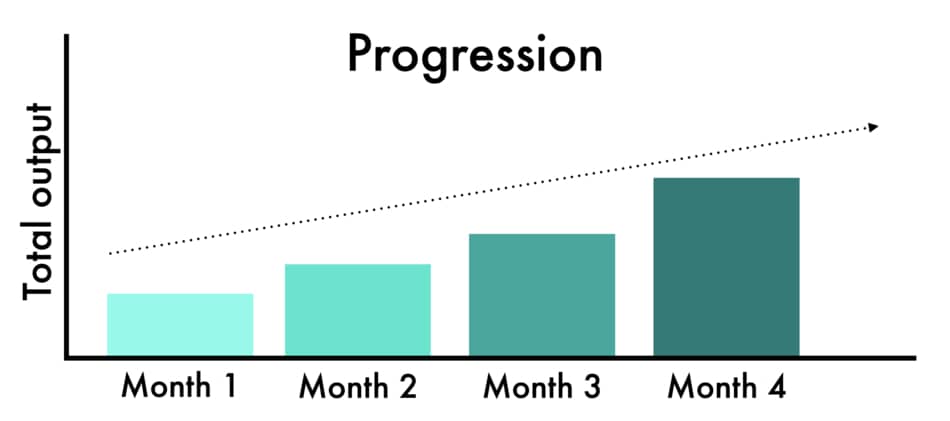One of the easiest ways to track your progress on peloton is to use their metrics, particularly total output.
Today I will explain what the total output means on the peloton, and most importantly, what the difference is between your average output and your total output.

What Is Peloton Total Output
The peloton’s total output is the amount of energy you generate expressed in kilojoules (kJ) throughout the peloton class, and it’s the valid measure for training load.
Things that will impact your total power output are exercise intensity and class duration.
This bike metric allows me to calculate and track my effort level.
What I love about the peloton total output score is not only a reflection of my progress but also an indicator of my current performance.
However, I don’t use the total output as a way to compete with others.
What can impact Peloton’s total output?
There are dozens of things that may affect your total power output:
- Your fitness level
- Your age
- Your gender
- Your body weight
- Power-duration relationship
1. Fitness level
With experience comes the ability to adjust one’s body position while pedaling; pushing back against the saddle while leaning forward over the handlebars improves power output as it maximizes the efficiency of hip extension.
Good positioning also makes it easier for veteran cyclists to maintain an efficient peddling rate, which further can enhance watts generated per pedal stroke.
2. Age
Aging leads to changes in muscle mass, as well as lower the ability to generate peak power output and VO2 max for a long duration.
Studies have shown that “anaerobic power output during cycling decreased by approximately 7.5% per decade following the teenage years” (Martin et al. 2000).
3. Gender
It’s not a secret that men are stronger than women and can generate significantly more total output on the bike.
Studies have shown that “men demonstrate up to 103% higher power output, and up to 71% higher VO2peak, compared to women” (Hegge et al. 2016).
4. Bodyweight
Your body weight does have an impact on the peloton’s total output of the bike. People with more body weight will typically generate more power.
5. The power-duration relationship
The power-duration relationship means that the increase in power requirement (e.g higher intensity) leads to higher muscle fatigue and lactate buildup, which results in a decrease in the workout duration.
In other words, taking a 20 minutes peloton HIIT ride will require a much higher effort level (resulting in faster depletion of muscle glycogen) which lowers total output.
On the other hand, the 90-minute power zone endurance ride requires less intensity, but you can maintain your pace for longer, which will result in higher total output.
That’s why comparing two different types of classes is not a viable way to evaluate your progress.
How is Peloton’s total output calculated?
You need to take the average output you’ve maintained throughout the class, multiply it by the time of the class in seconds, and divide by 1000.
For example, doing a 20-minute ride with an average output of 160 watts will result in total output of 192 kJ.
The difference between peloton total output and average output is that average output is the measurement of power (in watts) per second.
The total output is the summary of your total effort level at the end of the class.
In general, your average output will have a direct impact on your total output because of the formula.
Avg output (in watts) x seconds / 1000 = total output (in kJ)
Pelton total output formula
At the end of each class, the peloton software will calculate your average output as well as your total output.
Plus, you also have access to historical data where you can compare your achievements in peloton analytics.
What should my Peloton total output be?
It depends on how much time you spend on the bike, your resistance, and your cadence.
A good total output for the 30-minute ride can vary between 300 to 700 kJ, depending on your age, fitness, and even body weight.
In other words, there is no hard rule for your total output because this number will depend on multiple factors.
How To Use Peloton Total Output
One thing I love about the total output metric is it’s non-competitive, as well as it can be used for everyone, regardless of their level of fitness.
Here are a couple of ways you can use the total output to measure your progress.
Per class
You can use the peloton’s total output to monitor each workout, as long as you compare it to the same classes.
This means if you do the HIIT ride twice a week, you should only compare your total output with that ride, and not with other individual classes.

Of course, you still can do other classes, but if you want to look at the total output for the individual rides, you should stay within the same category.
Per month
Another way to use total output is to look at all the rides you did within the month collectively. I think this is more realistic for two reasons.
First thing is that most people change their classes every week to keep the variety (I know I always do). The second is you get more realistic improvements after 30 days, not just the 7 days.
See the graph below.

As you can see, it is much easier to track progress at month-by-month intervals.
Then, after 30 days you can take your average total output for the month, and set up the goal to beat that number for the next month.
Peloton Total Output vs Calories
The peloton’s total output and the number of calories burned are completely different metrics but they share one thing in common; they both can be used to track your progress.
Some people are used to tracking their calories burned and prefer these metrics as a way to “know” if they trained hard.
However, please remember that the peloton bike calculates calories based on the outdated METs formula.
Many things that are not related to your effort level (e.g. body composition) can affect calorie estimate, which makes this metric inaccurate.
On the other hand, the total output is a more realistic and precise way to assess your performance because it’s calculated based on the power sensor, not on the reference baseline.
The bottom line
Using peloton total output is a viable way to monitor your progress in a personalized, non-competitive way. Several factors can influence total output, which is why I don’t recommend trying to compete against others on the leaderboard.
The best way to use total output is as a progressive overload indicator on either class by class or month-by-month basis.
